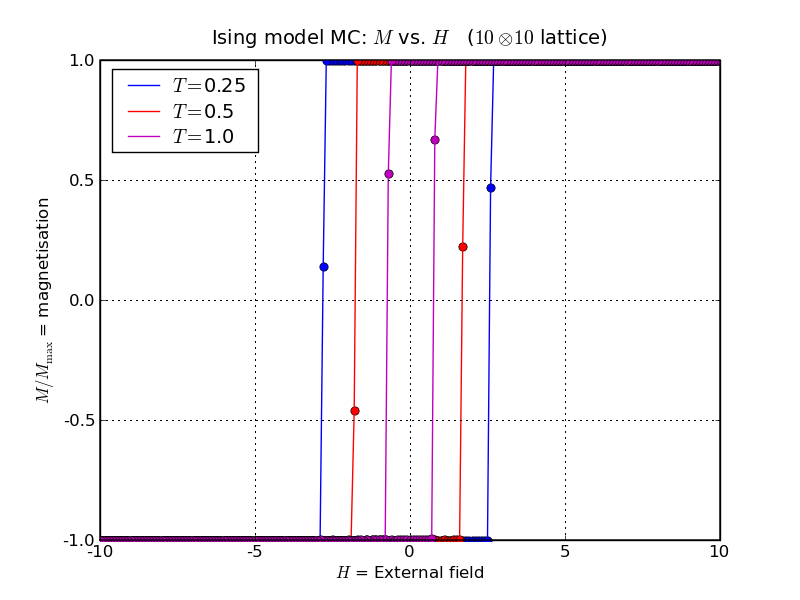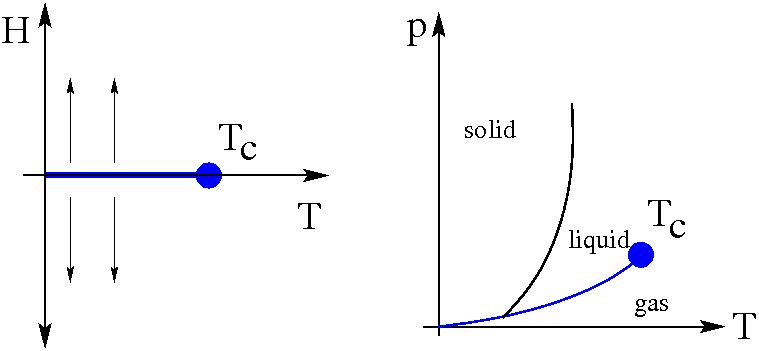
The phase transition in the Ising model that we have considered so far has
been of the second order. It is now time to address the concept of a first order
phase transition. These are very common in nature, such as the freezing of
water. In the Ising model that we have been investigating a first order phase
change can be achieved through the introduction of an external magnetic field.
The Monte Carlo method can once more be implemented here, with a slight
alteration to include the energy that will be gained or lost through a flip, due
to the applied field.
The difference between first order and second order phase transitions is that
there are large fluctuations before a second order phase change, which act as a
'warning' that unusual behaviour is about to occur. However, first order phase
changes occur abruptly, and do not have any prior fluctuations.
Now that there is the extra included variable of the external field, H,
there is a larger phase diagram to explore. Initially we will choose a low
temperature, T=1.0, at which we know the spins show good alignment, even
without the presence of the external magnetic field. In this case, the external
field will not significantly increase the alignment, but serve to direct the
orientation of the magnetic field, M, of the system. The field energy
will tend to align the spins with H. Therefore, as H changes from
being negative to positive, the sign of the field, M, will also
change abruptly. We will therefore look at the behaviour of the magnetic field
at the area around H=0. This is a discontinuous change and a sign of a
first order phase transition.
An example of how this occurs at varying temperature for a 10 × 10 lattice
is shown below

By the symmetry of the situation, it would be expected that the change
occurs at H=0. However, while the changes occur at around H=0,
there is occasionally a hysteresis connected with the transition. This
causes the change to occur at a point slightly displaced from H=0, and can
be seen above. This hysteresis occurs due to a metastable
state where M < 0 with H > 0 that occurs at small values of
H.
Here are some hysteresis curves for low temeratures

This shows the hysteresis loops that cause the discontinuities for first order phase changes to occur at values of H other than H=0. As the temperature increases, the metastable states become less prominent and the hysteresis curve becomes narrower.
At temperatures above Tc, the spontaneous alignment of the spins disappears. Therefore, the strength and direction of the magnetic field determines the direction of the magnetisation and the strength of alignment of the spins. This creates a smoother transition at small values of H, and therefore there is no discontinuity or hysteresis. This is the point where first order phase transitions no longer occur.
The discontinuity in the first order phase change is twice the spontaneous magnetistaion that occurs without the external field. This spontaneous field disappears at Tc. This implies that the first order phase transition as a function of H is closely related to the second order phase transition as a function of T.
A common example of a first order phase change is the freezing of water into ice, or the evaporation of water. This idea can, of course be extended to any substance that has the ability to change between three phases via a first order phase change. We will now compare two phase diagrams, one of a substance with three phases, solid, liquid and gas, and one of the phase change we have been considering in the Ising model.

In both of these phase diagrams it can be seen that it is possible to move from one state to another by moving around the critical point, where the difference between two phases vanishes. After this point it is no longer possible for the system to undergo a first order phase change.